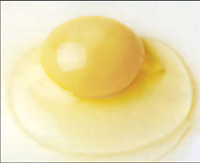
Pale yolks

Description
The colour of the yolk is due to substances called carotenoids. The nutritional value of the egg is not affected by the yolk colour. The intensity of yolk colour may be measured against standards such as the DSM Yolk Colour Fan. Most egg marketing authorities require deep-yellow to orange-yellow yolk colours in the range 9 to 12 on the DSM Yolk Colour Fan. Yolks of more intense colour may be required for specifi c markets.
The most important sources of carotenoids in poultry feed are maize (corn), maize gluten, alfalfa (lucerne) and grass meals; these sources contain the pigmenting carotenoids lutein and zeaxanthin, which, together with other oxygen-containing carotenoids, are known by the collective name of xanthophylls.
However, the carotenoid content in the ingredients of poultry feed is not constant; the pigmentation properties of the carotenoids can be weakened or lost in a variety of ways. These fluctuations in carotenoid content and availability concern both the poultry nutritionist and the feed producer. Because of such fluctuations, naturally-occurring carotenoids cannot be relied upon to provide the desired yolk colour or to provide a consistent colour. Therefore, nature-identical yellow and red carotenoids, such as apoester and canthaxanthin, are commonly added to feed in order to achieve the desired egg yolk colour. Consumed by the laying hen, these supplemental carotenoids are readily transferred to the blood and then deposited in the yolk to provide pigmentation.
Incidence
A wide variation in colour may normally be expected in the yolks from any flock. If a flock averages a yolk colour score of 10 on the DSM Yolk Colour Fan, two out of every three eggs laid by the flock will score between 9 and 11. Also, one egg in 20 will score less than 8, and one in 20 greater than 12.
| Cause | Control |
|---|---|
| Deterioration of pigment concentrates | Keep concentrates and premixes in airtight containers, in a cool place and away from sunlight. Store for short periods only. |
| Insufficient carotenoids in the feed | The required yolk colour score, the percentage of egg production and daily feed consumption of the flock are the major factors governing the amount of pigment needed in the layer diet. Adjust levels of natural or synthetic carotenoids to meet these needs. Do not rely too much on feed ingredients such as lucerne or maize, whose pigment concentrations can vary widely. |
| Insufficient pigment in birds that are coming into lay | Flocks coming into lay may have insufficient stores of pigment. Start feeding pigment sources 2 to 3 weeks before the fl ock starts to lay. |
| Oxidising agents or pigment antagonists in the feed | The addition of a recommended antioxidant to feed will help preserve yolk pigments. Either do not include high levels of barley or triticale in the diet, or, if they are included, adjust pigment levels to higher than normal concentrations. |
| Inadequate mixing of feed | Always blend concentrates in a premix before adding to the rest of the feed for mixing. Make sure that mixing time is adequate. |
| Storage of feed in damp and/or hot conditions | Keep feed cool and dry. |
| Rough handling or transport of feed | Mixed feed should be handled carefully so that the various components do not separate out. This particularly needs to be checked when augers and automatic feeding systems are used. |
© The State of Queensland, Australia (through its Department of Primary Industries and Fisheries) and DSM Nutritional Products Ltd., 2007. No part of this publication may be reproduced, copied or transmitted save with prior written permission of Director, Intellectual Property Commercialisation Unit, Department of Primary Industries and Fisheries, GPO Box 46 Brisbane, Queensland, Australia 4001, and DSM Nutritional Products Ltd.






